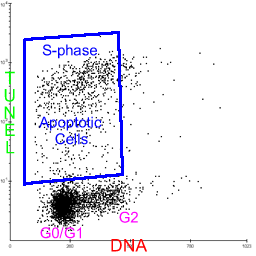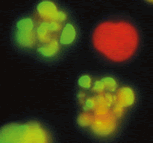Reagents

About us | Contact us | Ordering | Home


Apoptosis is programmed cell death occurring in multi-cellular organisms. Programmed cell death is the death of any cell mediated by an intracellular process. Necrosis in contrast to apoptosis , is an abrupt, rapid cell death that is usually a result of tissue injury which provokes an inflammatory response in the organism. Apoptosis is a distinct series of biochemical events that trigger characteristic morphological and biological changes in cells during its progression without any sort of inflammatory response. It is estimated that 50 to 70 million cells die in the human body each day by apoptosis.. When apoptosis occurs, the nucleus and cytoplasm of the cell often fragment into membrane-bound apoptotic bodies that are then phagocytosed by neighboring cells. This is called blebbing.(See color picture at right). Another event that occurs before blebbing is lost of cell membrane symmetry. Both of these events (blebbing & loss of cell membrane symmetry) can be measured with reagent kits sold by Phoenix Flow Systems.(Apo-BrdU & V-Annexin V respectively)

This change in cell membrane structure can be measured using our V-Annexin V reagent kit. The Annexin V method has the advantage of being relatively fast but requires the cells be fresh and alive. Complication arise when testing adherent cells as methods used to lift these cells may disturb the cell membrane resulting in false or hard to interpret results.. For this reason, we recommend all adherent cell lines be detached with, to minimize this artifact.
The fragmentation of the cellular DNA later in the apoptotic pathway can be measured with two reagent kits we offer. APO-BrdU and APO-Direct . These are TUNEL assay kits. TUNEL stands for Terminal Deoxynucleotide Transferase dUTP Nick End Labeling. (I don't think that will be on Jeopardy!) In the TUNEL assay, TdT enzyme acts as a catalyst so template independent labeling of nucleotides of nicks in the DNA caused by apoptotic pathway occurs. These incorporated nucleotides can be fluorescently labeled and measured with a flow cytometer. In reality, the nicks in the DNA caused by the apoptotic pathway are breaks. So, since our company is based in California(surfing mecca), we like to refer to the assay as the TUBEL assay, not TUNEL.
The TUNEL assay has certain advantages and disadvantages over the Annexin V measurement. First the bad points, the TUNEL assay takes longer to stain your cells and they must be fixed overnight. Second, the TUNEL assay costs more. Now the good points, samples to be analyzed with the TUNEL assay can be batched after fixing and stored in the freezer for a long time (weeks, months). The fixation procedure only takes a little while and is a paraformaldehyde-ethanol fixation. The TUNEL assay is considered the "gold standard" for measuring apoptosis because is works on 95% of cells. The TUNEL assay also gives one more key piece of information which the Annexin V assay doesn't. The phase of the cell cycle where apoptosis is occurring. Are the cells going apoptotic in S-phase or G2-phase? This is accomplished by the use of a DNA counter stain (Propidium Iodide) included in the flow cytometry version of the kits. No other apoptosis assay gives this information simultaneously..
PFS has three TUNEL apoptosis labeling kits: APO-BrdU, APO-Direct and APO-BrdU-IHC. APO-BrdU and APO-Direct are used for flow cytometry or fluorescent image cytometry. APO-BrdU-IHC is used for light microscopy (Methyl Green and DAB). All the kits have all the necessary reagents to perform the assay plus positive and negative control cells or slides in the case of the APO-BrdU-IHC kit. The controls eliminate the staining variables in your experiments. The difference between the APO-BrdU and APO-Direct kits is that apoptotic cells will be more strongly labeled (easier to see) with APO-BrdU, while the labeling process is faster with APO-Direct. It has been shown that PFS' APO-BrdU kit is the best performer on the market (publication available on request). With APO-Direct, fewer FITC-dUTP’s, are bound to each DNA strand nick. So, it's faster (because there is one less 20 min incubation in the protocol) but each site is somewhat less strongly labeled. On the other hand, if the labeling with APO-Direct is bright enough, the timesaving and higher cost (50 assays in APO-Direct Kit, 60 assays in APO-BrdU Kit) may be important to the customer. The sensitivity enhancement carries over to the APO-BrdU-IHC kits. In comparisons done between tissues stained with the APO-BrdU-IHC kit verses a standard dUTP-biotin/strept-avidin reaction, the contrast between the background staining and the apoptotic cells seems greater. We say seems because light microscopy is such a subjective field.
